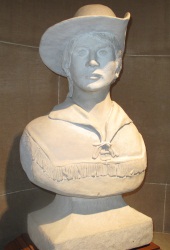
Explored the Ohio River (1772, 1773-74)
- Fought the British for control of Vincennes (1779)
- Secured 1,000 acres for establishment of Clarksville
Bust Location
Statehouse Rotunda, 4th floor, Facing north, east corner
Born
Charlottesville, Virginia
Lived
Clarksville
George Rogers Clark was born on November 19, 1752 in Charlottesville, Virginia. He was the second of 10 children born to John and Ann Clark. His youngest brother, William, went on to become famous for his role in the Lewis and Clark expedition. During George’s childhood, the Clark family lived on multiple farms, and in that time the children did not receive much formal education. Independent reading gave Clark a comprehensive reading and writing ability, though many of his journals display the crudeness of his writing skills, full of misspellings and grammatical mistakes.46
When he was 19 years old, George Rogers Clark began to learn the craft of land surveying from his grandfather. This interest led Clark to form a group which travelled from Pittsburgh to explore the Ohio River in canoes in June of 1772. Clark acquired some land on this trip, and would explore the Ohio River on a subsequent trip in 1773-74. In 1774, Clark joined Lord Dunmore’s campaign against Indians in the Pittsburgh area, and it was this short military experience which gave George Rogers Clark the leadership credentials that he would need later on the frontier, especially when asked to fight off Indian attacks.47
Clark made his first visit to Kentucky in 1775, as part of a land surveying trip.48 News of increased Indian attacks on Kentuckians led Clark to call a meeting of representatives from the forts at Harrodsburg, Ky. in June of 1776. From this meeting, it was decided that Clark would travel to Virginia and ask the General Assembly to officially consider Kentucky as a county of Virginia. The assembly was initially resistant to the idea, but Virginia Governor Patrick Henry pushed for his cause, and Clark was granted 500 pounds of gunpowder for use in Kentucky’s defense. Kentucky was also made a county of Virginia. Clark was only 24 when he accomplished this.49
Leading into 1777, the Kentucky colony was facing serious threats from Indians, as well as the British-controlled lands nearby. Clark conceived the plan to attack British forces on the Mississippi and in Detroit, and he asked for Virginia’s support in this endeavor. He only received minimal support from Virginia. Clark mounted a very small volunteer army of approximately 175 men and set out to attack the town of Kaskaskia (now in Illinois), which was controlled by the British. On July 4, 1778, Clark and his army surprised the town and were able to capture it from the British without firing a single shot. Clark then sent some of his men ahead to capture another settlement up the Mississippi River, Cahokia.50
Following the success at Kaskaskia, Father Gibault (the settlement’s priest) went to Vincennes to secure the allegiance of the French in July of 1778. Once they had agreed to support the Americans in their efforts, Clark sent Captain Leonard Helm to take command of Fort Sackville in Vincennes. This did not sit well with Henry Hamilton, the British lieutenant governor of Detroit, who left there on October 7 to retake Fort Sackville from Helm. On December 17, Hamilton arrived in Vincennes and took control of the fort.51
Francis Vigo, a Spanish trader who lived in Vincennes at the time, was able to leave the city to travel to St. Louis and report the news of Hamilton’s plans to Clark. Though it was in the middle of winter and Clark did not have numbers on his side, he thought that it would be best to travel to Vincennes immediately to challenge Hamilton’s control of Fort Sackville. Clark and his men left on February 6, 1779, surprising Vincennes on February 23. After three days of battle, Hamilton surrendered the Fort back into American hands.52
While Clark had originally planned to attack the British in Detroit, his plans were delayed multiple times, and he was never able to realize that goal. He settled in Louisville in 1779, and continued to defend Kentucky against Indian attacks and from British control for three years. In 1782, Virginia relinquished their claims on the Northwest Territory, so Kentucky was no longer considered a county of that state. In 1783, Clark and his men were granted 149,000 acres, includes 1,000 for the settlement of a town on the Indiana side of the Falls of Ohio. This land became the location of Clarksville in 1784.53
After the success at Fort Sackville, Clark continued to lead military actions in the Northwest Territory until the end of the War of 1783. In 1784, he was named the principal surveyor of public lands for men who served in the Virginia military forces. He consulted on Indian affairs as well, until he retired to Clarksville, Indiana in 1803. It was there that he built a log cabin and operated a grist mill in the town. In 1809, Clark suffered a stroke which left him partially paralyzed and required the amputation of his leg. From then on, it was necessary for Clark to live in Locust Grove, Kentucky with his sister Lucy and her husband William Croghan. A third stroke at the age of 66 on February 13, 1818 caused Clark’s death.54 Clarks body was initially buried in the Croghan family plot in Locust Grove, but on October 29, 1869, Clark’s body and those of other family members were reinterred at Cave Hill Cemetery in Louisville.55
Bust History
This bust was sculpted by David McLary in 1985, and a mold was made through a casting process. Eight total casts have been made from the mold, the one in the Indiana Statehouse being one of those eight. Only two other casts are accounted for: one which is located in George Rogers Clark Elementary School in Clarksville and one in the Clarksville City Hall. The bust in the Statehouse is located on the third floor, in a niche facing the South Atrium.56
Sculptor
David McLary
David McLary is an Indianapolis-based artist and employee of the Indiana State Museum.57
46 Indiana Historical Bureau. “George Rogers Clark Biography.” 1979. http://www.in.gov/history/2958.htm.
47 “George Rogers Clark.” Historic World Leaders. Gale, 1994. Gale Biography in Context.
48 Ibid.
49 Indiana Historical Bureau. “George Rogers Clark Biography.”
50 “George Rogers Clark.” Historic World Leaders.
51 Indiana Historical Bureau. “The Fall of Fort Sackville - A Timeline.” http://www.in.gov/history/2421.htm.
52 Indiana Historical Bureau. “George Rogers Clark Biography.”
53 Haffner, Gerald O. “The Hoosier Connection of George Rogers Clark.” New Albany, Indiana: Indiana University Southeast Bookstore, 1980. p 9-10.
54 Indiana Historical Bureau. “George Rogers Clark Biography.”
55 Indiana Historical Bureau. “Clark’s Death.” http://www.in.gov/history/2972.htm.
56 “George Rogers Clark (bust).” http://en.wikipedia.org/wiki/George_Rogers_Clark_%28bust%29.
57 Ibid.
